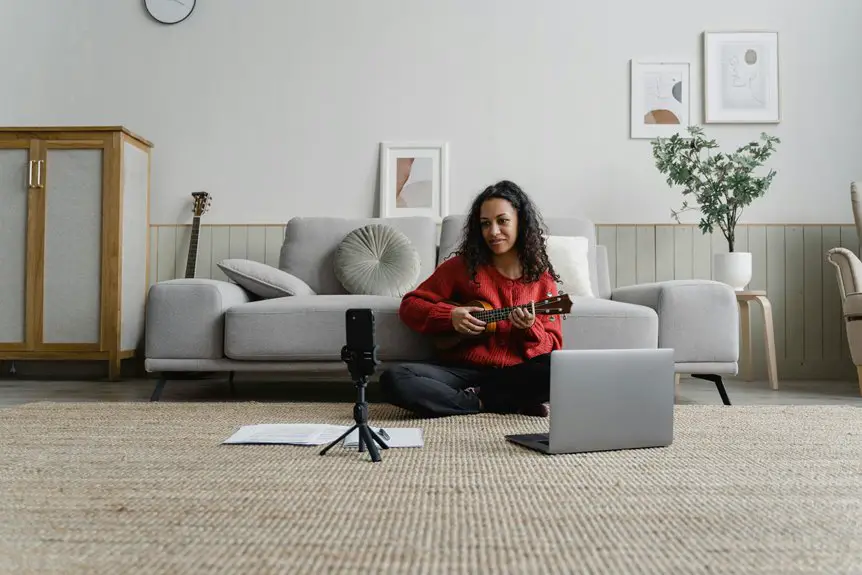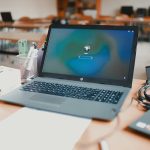To use Zoom effectively for remote music lessons, start by setting up your account and optimizing your profile. Choose quality audio equipment and create a dedicated teaching space that's quiet and well-lit. Utilize Zoom's interactive features like breakout rooms, annotations, and screen sharing to enhance engagement. Maintain clear communication and provide timely feedback to foster student growth. There's much more you can learn to elevate your online teaching experience.
Table of Contents
Key Takeaways
- Set up a dedicated teaching space with good lighting, minimal distractions, and organized instruments for a professional learning environment.
- Optimize your Zoom settings, including audio and video configuration, to ensure clear communication and sound quality during lessons.
- Utilize Zoom features like breakout rooms for group practice, screen sharing for demonstrations, and annotation tools for visual aids.
- Maintain clear communication by regularly checking in with students and providing constructive feedback to enhance their learning experience.
- Engage students with interactive elements and celebrate their achievements to foster motivation and a supportive learning atmosphere.
Setting Up Your Zoom Account for Music Lessons
Before you plunge into your remote music lessons, you'll need to set up your Zoom account effectively.
Start by downloading the Zoom app or accessing it through your browser. Create an account using a valid email address; you'll receive a confirmation link to activate it.
Once you've logged in, familiarize yourself with the interface. Make certain to update your profile with a professional photo and your name.
Familiarize yourself with the Zoom interface and enhance your profile with a professional photo and your name.
Adjust your settings for video and audio to guarantee the best experience during lessons. You can enable the waiting room feature to control who enters your sessions.
Finally, practice scheduling a meeting, so you're comfortable with the process before your first lesson. This setup will help your lessons run smoothly and professionally.
Choosing the Right Equipment for Optimal Sound Quality
To achieve the best sound quality for your remote music lessons, you'll need the right equipment.
An essential audio interface and a quality microphone can make a significant difference in how your music is heard.
Let's explore how to select these tools effectively.
Essential Audio Interfaces
Investing in a quality audio interface is essential for achieving ideal sound quality during remote music lessons. This device converts your instrument or voice into a digital signal that Zoom can transmit effectively.
Look for an interface with low latency to guarantee real-time sound without delays, which can disrupt your lesson. A solid choice is one with at least two inputs, allowing you to connect both a microphone and an instrument simultaneously.
USB interfaces are user-friendly and compatible with most computers. Additionally, check for built-in preamps to enhance your audio clarity.
Prioritizing a reliable audio interface will greatly improve your lesson experience, helping you communicate and perform better with your students. Don't underestimate its impact on your overall sound quality!
Quality Microphones Selection
Selecting the right microphone can make all the difference in your remote music lessons. A good microphone captures your sound clearly, ensuring your students hear every note accurately.
USB microphones are user-friendly and often provide great quality for beginners. If you want to take it a step further, consider an XLR microphone paired with an audio interface for superior sound.
Condenser microphones are excellent for vocals and acoustic instruments, while dynamic microphones work well for louder sounds.
Don't forget to invest in a pop filter to reduce plosive sounds and a boom arm for proper positioning. Experiment with different options to find what works best for your style and setup, and you'll enhance the overall learning experience for your students.
Creating a Dedicated Teaching Space
Creating a dedicated teaching space can greatly enhance your remote music lessons. Choose a quiet area in your home where you won't be interrupted.
Make certain it's well-lit, so your students can see you clearly. Consider using a plain backdrop to minimize distractions. Set up your instrument and equipment within reach, guaranteeing everything's organized for smooth changes.
You might want to invest in a comfortable chair and a desk if you plan to teach music theory or use a computer. Personal touches like posters or musical notes can add character to the space.
Finally, test your internet connection and camera angles before lessons to confirm a professional experience. A well-prepared environment sets the tone for engaging and effective teaching.
Utilizing Zoom Features for Interactive Learning
As you immerse yourself in remote music lessons, utilizing Zoom's features can greatly enhance interaction and engagement. Start by using the breakout rooms for small group practice sessions, allowing students to collaborate and learn from each other. The annotation tool can let you draw on shared screens, highlighting important techniques or notes. Use the chat feature to encourage questions and feedback in real-time, making your lessons more dynamic.
Here's a quick overview of Zoom features that can boost your interactive learning experience:
| Feature | Benefit |
|---|---|
| Breakout Rooms | Foster collaboration |
| Annotation Tool | Visual teaching aids |
| Chat | Instant feedback |
| Polling | Gauge student understanding |
| Screen Sharing | Show examples easily |
Engaging Students With Virtual Tools and Resources
While teaching remotely, engaging students with virtual tools and resources can make a significant difference in their learning experience. Use interactive platforms like music notation software or online metronomes to enhance lessons. Sharing your screen to demonstrate techniques or play examples keeps students focused and involved.
Encourage students to use apps for practicing scales or recording their progress. Incorporate online games that relate to music theory to make learning fun. Utilize Zoom's breakout rooms for group activities, allowing students to collaborate on projects.
Troubleshooting Common Technical Issues
When you're using Zoom for music lessons, technical issues can pop up unexpectedly.
You'll want to keep an eye on your internet connection, adjust your audio settings, and optimize video quality for the best experience.
Let's tackle these common problems so you can focus on making music instead of troubleshooting.
Internet Connection Stability
To guarantee a smooth experience during your remote music lessons on Zoom, you'll want to prioritize a stable internet connection. A shaky connection can disrupt your flow and make it hard for both you and your instructor to communicate effectively.
Here are some tips to ensure your internet is up to par:
- Use a wired connection for more reliability over Wi-Fi.
- Close unnecessary applications to free up bandwidth.
- Position yourself close to the router to improve signal strength.
- Run a speed test to check your download and upload speeds before the lesson.
Audio Settings Adjustment
Adjusting your audio settings can make a significant difference in the quality of your remote music lessons on Zoom.
First, check your microphone settings by clicking on the arrow next to the microphone icon in the bottom-left corner. Choose your preferred microphone and verify it's not muted.
Next, enable the "Original Sound" feature in your audio settings. This allows your music to be transmitted without any processing that could distort it. You may also want to disable the background noise suppression feature for clearer sound.
Finally, test your audio before each lesson by playing an instrument and listening for clarity. These adjustments will help you and your instructor communicate effectively and enhance your learning experience.
Video Quality Optimization
After you've fine-tuned your audio settings, it's time to focus on video quality optimization. A clear video makes a huge difference during your remote lessons.
Here are some tips to enhance your video quality:
- Use a high-resolution camera: If possible, opt for an external webcam for better clarity.
- Adjust lighting: Natural light works wonders; position yourself facing a window or use soft light sources.
- Check your internet connection: A stable, high-speed connection will prevent lag and pixelation.
- Close unnecessary apps: Free up bandwidth by shutting down any apps that aren't needed during your lesson.
Maintaining Communication and Feedback With Students
While using Zoom for remote music lessons, it is crucial to maintain clear communication and provide constructive feedback to your students. Regularly check in with them to gauge their understanding and progress. Use specific examples from their performances to highlight strengths and areas for improvement.
Here's a simple table to help you structure your feedback:
| Feedback Type | Examples | Purpose |
|---|---|---|
| Positive Reinforcement | "Great rhythm!" | Boost confidence |
| Constructive Critique | "Try slowing down here." | Encourage improvement |
| Goal Setting | "Let's work on scales." | Focus future lessons |
Frequently Asked Questions
Can I Record My Zoom Music Lessons for Later Review?
Yes, you can record your Zoom music lessons for later review. Simply click the "Record" button before starting your session. This way, you'll have a helpful resource to revisit your lessons and improve your skills.
How Do I Share Sheet Music or Files During a Lesson?
To share sheet music or files during your lesson, click the "Share Screen" button, select the desired file or application, and then share. This way, your student can see and follow along easily.
What Is the Best Internet Speed for Smooth Streaming?
For smooth streaming, you'll want at least 3 Mbps upload and download speeds. Higher speeds guarantee better quality, reducing lag and buffering, so you can focus on your lesson without interruptions or frustrations.
Can I Use Zoom on a Tablet or Smartphone?
Yes, you can use Zoom on a tablet or smartphone. Just download the app from your device's app store, sign in, and you're ready to connect with others easily, no matter where you are.
How Do I Handle Students' Technical Issues During Lessons?
When students face technical issues, stay calm and patient. Encourage them to troubleshoot by checking their internet connection, adjusting settings, or restarting the app. Offer guidance and support, keeping the lesson productive and engaging.




